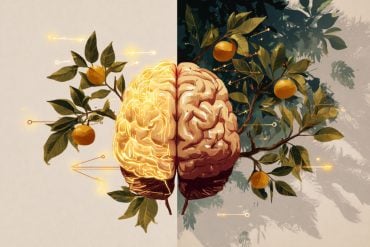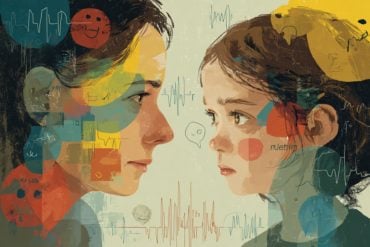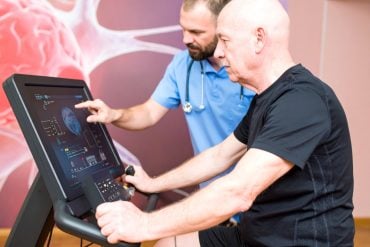Summary: Professional jazz musicians play certain combinations of notes and “licks” with more constant timing and force than other notes. Findings suggest jazz musicians possess a collection of patterns that are directly grounded in their brains and bodies.
Source: Aarhus University
World-renowned jazz musicians are often praised for their creative ingenuity. But how do they make up improvisations? And what makes artists’ solos more enticing than those of less skilled players?
These questions continue to puzzle not only jazz aficionados, but also psychological researchers. Two leading theories have dominated so far: Either musicians learn to master rules telling them what they can and cannot play – a sort of “secret language of jazz.”
Or, each musician builds up a personal library of melodic patterns – “licks” – that they can draw upon and recombine in new and interesting ways. Over the years, musical scholars have collected many such volumes of “licks” for learners to practice.
Yet, the fact that a certain combination of notes recurs many times is no proof of an underlying movement pattern stored in the brains of musicians—it could just be a sheer coincidence.
The ‘library theory’ of jazz improvisation
A new scientific study, just published in the journal Cognition, provides the first solid psychological evidence for the library theory of jazz improvisation.
For the first time ever, researchers from Aarhus University and Georgia State University found that expert jazz musicians play certain note combinations with much more consistent timing and force than others. Regardless if these “licks” were played fast or slow, loud or soft, the relative rhythms and accents remained very similar.
This strongly suggests that each player possesses a collection of patterns that are directly grounded in their own body and brain. Many jazz experts have called it their personal “vocabulary.” Interestingly, the new study found that these improvisation vocabularies vary between different players.

Martin Norgaard, born and raised in Denmark, now Associate Professor of Music Education at Geogia State University in Atlanta comments further: “It is fascinating that expert jazz musicians store linked audio and motor representations in the brain – that is both the sound of licks and information about how to play them.
“As a jazz violinist myself, I often hear licks I want to play while improvising but the motor representation is not complete so the lick doesn’t come out right. Based on our research, that should happen less as expertise develops.”
Stylistically appropriate and novel – hallmarks of creativity
Using an advanced computer model, the researchers furthermore showed that “licks” tend to occur in relatively predictable contexts but simultaneously evoke greater surprise and uncertainty in the listener.
This finding fits well with leading theories in psychology and neuroscience about human creativity and what makes certain types of music particularly enjoyable to listen to. Specifically, melodies in the personal vocabularies of jazz improvisers are typically both stylistically appropriate and novel—the two hallmarks of creativity according to scientists.
“The fact that the solos of jazz experts evoke strong expectations in listeners and simultaneously surprise them might be exactly what makes these melodies so catchy and memorable.
“This may ultimately help us understand why some musicians become famous while others don’t,” said senior author Niels Chr. Hansen, Assistant Professor at Aarhus Institute of Advanced Studies at Aarhus University, Denmark.
The research results – how did they do it?
- The researchers analysed nearly 100,000 notes played on a MIDI keyboard by the artist-level jazz pianist Kevin Bales, during 11 live music gigs for audiences in the United States. This collection of solos was compared to recordings of 25 experienced jazz pianists taking part in a previous laboratory experiment.
- For each recurring 5-note sequence, the durations of notes and the force with which they were played were compared across versions of the same pattern to find the set of licks that were played the most consistently across different tempi and loudness.
- A computational model was trained on the Weimar Jazz Database consisting of more than 200,000 notes from 456 improvised songs by various jazz artists to estimate how much surprise and uncertainty each note in Kevin Bales’ improvised solos would evoke in an average jazz listener.
Funding: The study has received funding from the European Union’s Horizon 2020 research and innovation program under the Marie Skłodowska-Curie grant agreement No 754513 and The Aarhus University Research Foundation.
About this music and neuroscience research news
Author: Lena Bering
Source: Aarhus University
Contact: Lena Bering – Aarhus University
Image: The image is in the public domain
Original Research: Closed access.
“Linked auditory and motor patterns in the improvisation vocabulary of an artist-level jazz pianist” by Niels Christian Hansen et al. Cognition
Abstract
Linked auditory and motor patterns in the improvisation vocabulary of an artist-level jazz pianist
Improvising musicians possess a stored library of musical patterns forming the basis for their improvisations. According to a prominent theoretical framework by Pressing (1988), this library includes linked auditory and motor information.
Though examples of libraries of melodic patterns have been shown in extant recordings by some improvising musicians, the underlying motor component has not been experimentally investigated nor related to its auditory counterparts.
Here we analyzed a large corpus of ∼100,000 notes from improvisations by one artist-level jazz pianist recorded during 11 live performances with audience.
We compared the library identified from these recordings to a control corpus consisting of improvisations by 24 different advanced jazz pianists. In addition to pitch, our recordings included accurate micro-timing and key velocity (i.e., force) data.
Following a previously validated procedure, this information was used to identify the underlying motor patterns through correlations between relative timing and velocity between notes in different iterations of the same pitch pattern.
A computational model was, furthermore, used to estimate the information content and generated entropy exhibited by recurring pitch patterns with high and low timing and velocity correlations as perceived by a stylistically enculturated expert listener.
Though both corpora contained a large number of recurring patterns, the single-player corpus showed stronger evidence that pitch patterns were linked to motor programs in that within-pattern timing and velocity correlations were significantly higher compared to the control corpus. Even when controlling for potentially greater baseline levels of motor self-consistency in the single-player corpus, this effect remained significant for velocity correlations.
Amongst recurring 5-tone pitch patterns, those exhibiting more consistent motor schema also used less idiomatic pitch transitions that were both more unexpected and generated more uncertain expectations in enculturated experts than less consistently repeated patterns.
Interestingly, we only found partial evidence for fixed pattern boundaries as predicted by the Pressing model and therefore suggest an expanded view in which the beginning and ends of idiomatic audio-motor patterns are not always clear-cut.
Our results indicate that the library of melodic patterns may be idiosyncratic to the individual improviser and relies both on motor programming and predictive processing to promote stylistic distinctiveness.







